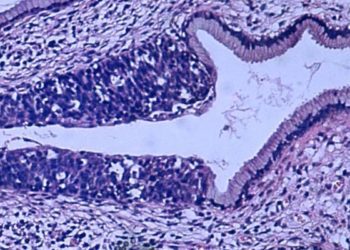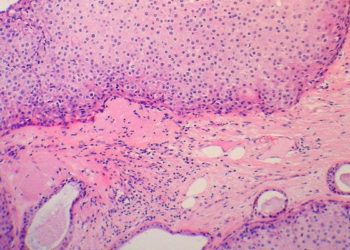Endocrine therapy and breast-conserving surgical management without follow-up radiotherapy is safe in low-risk, luminal A subtype breast cancer
1. 5-year recurrence incidence was 2.5% at follow-up.
2. Overall survival at 5 years without radiotherapy was 97.2%, with a disease-free survival rate of 89.9%.
Evidence Rating Level: 1 (Excellent)
Study Rundown: After breast-conserving surgical management of breast cancer, radiotherapy is often provided to help prevent recurrence, but not without inconvenience, increased risk of side effects, and considerable cost financially. Low-risk subtypes of breast cancer include the luminal A-subtype, described as having negative human epidermal growth factor receptor 2, estrogen receptor positivity of ≥1%, progesterone receptor positivity of >20%, and Ki67 index of 13.25% or less. The Ki67 index can be used to distinguish between low- and high-risk subtypes. This study prospectively examined the outcomes of recurrence in selectively chosen, low-risk female patients age 55+ years with subtype A breast cancers, whose treatment omitted radiotherapy, and who were provided only breast-conserving surgery after endocrine therapy. The primary outcome of this study was the recurrence of invasive or in situ cancer of the ipsilateral breast. Secondary outcomes included disease-free survival and overall survival. Median follow-up time was 5 years after treatment, at which point a local recurrence was noted in 10 patients, all of which were invasive. A total of 8 contralateral recurrences were observed in 5 years. There were 47 disease events recorded during follow-up, for a 5-year disease-free survival of 89.9%. Overall survival at 5 years was 97.2%. Limitations to this study include that the study population age was limited to age 55 or older. The results of this study should be applied cautiously to populations younger than this. Also, as the study population excluded patients with lobular cancer, multifocal tumours, extensive intraductal involvement or lymphovascular invasion, results from this study may not apply to these groups. Overall, the results from this study support that the omission of radiotherapy after conservative breast-sparing surgery and endocrine therapy for low-risk, luminal A subtype breast cancer is an effective management approach.
Click to read the study in the NEJM
Relevant Reading: Radiation therapy after breast-conserving surgery in women 70 years of age
and older: how wisely do we choose?
In-Depth [prospective cohort]: This study was a prospective cohort study that followed 500 adult female patients from 26 centres in Canada who were at least 55 years old and who received only breast-conserving surgical treatment and adjuvant endocrine therapy for their grade 1 or 2, T1N0, luminal A-subtype breast cancer. With a median follow-up time of 5 years, there were only 10 local recurrences noted. Cumulative incidence at 5 years post-treatment was found to be 2.3% (90% confidence interval [CI], 1.3 to 3.8; 95% CI, 1.2 – 4.1). The 5-year recurrence incidence was calculated to be 2.5% (90% CI, 1.5 – 4.0). The 5-year cumulative incidence of contralateral breast cancers was 1.9% (90% CI, 1.1 – 3.2). The disease-free survival at 5 years was 89.9% (90% CI, 87.5 – 92.2%). At 5 years, the overall survival was 97.2% (90% CI, 95.9 – 98.4%). These findings support that standard treatment omitting radiotherapy in a low-risk luminal A phenotype results in a very low incidence of local recurrence at 5 years.
Image: PD
©2023 2 Minute Medicine, Inc. All rights reserved. No works may be reproduced without expressed written consent from 2 Minute Medicine, Inc. Inquire about licensing here. No article should be construed as medical advice and is not intended as such by the authors or by 2 Minute Medicine, Inc.





![Addition of bevacizumab fails to benefit overall survival in newly diagnosed glioblastoma [RTOG 0825 trial]](https://www.2minutemedicine.com/wp-content/uploads/2014/02/AFIP-00405558-Glioblastoma-Radiology-e1381685577283-75x75.jpg)

